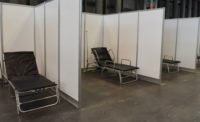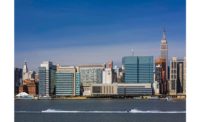Affordable Multifamily Housing Projects Adapt to Covid-19

Communal terrace space on the roof of Marin Architects’ project in the Bronx allow residents to safely gather outdoors. Image courtesy Marin Architects
In the Bronx, New York, the congregation of Wakefield Grace United Methodist Church is replacing their longtime house of worship, a 1927 stone Gothic-revival structure. But instead of just building a new church, the congregants decided to construct a 72-unit affordable-housing complex for seniors on top of a new ground-level sanctuary. And their architect, Walter Marin, is ensuring that the church’s act of faith and civic philanthropy will help future residents stay healthy by designing a building that will combat the spread of the coronavirus and possible future viral outbreaks.
“There are so many things you can do to fight Covid-19,” says Marin, senior principal at Marin Architects in Manhattan, such as installing elevators that can be called via cell phone or utilizing UV lighting to kill germs. “But the challenge is finding applications within the budget constraints of affordable housing.” This is a growing concern for architects of this typology.
Given the lower chance of Covid transmission outdoors, Marin is making the most of open-air spaces. “New York City codes discourage individual balconies in affordable housing, so we’ve designed a roof garden, which is like a giant communal balcony,” he says. “It’s the one place you can gather at a reasonable distance, and, with movable furniture, tenants can personalize the space and make it into little pods.” The project is slated for completion in fall 2022.
But in Richmond, Virginia, an affordable-housing complex designed by Dallas-based global architecture firm HKS is going all-out for individual balconies. The Benefield Building, an Art Deco structure that formerly housed an auto-repair shop, will contain a mixture of retail and office space as well as 30 affordable apartments, all of which will have private outdoor space. The project—through the schematic design phase and now in a public review process—is anticipated to open in the second half of 2022. Located in the primarily African American neighborhood of Highland Park, the building will also be home to the Six Points Innovation Center (6 PIC), a makerspace and youth programming organization that encourages young people to pursue careers using both minds and hands.

Communal terrace space on the roof of the Benefield Building housing by HKS allows residents to safely gather outdoors. Image courtesy HKS, click to enlarge.
The design has air exchange with the outdoors, thus reducing aerosolized transmission of the virus. It also has multiple outdoor venues, including a large community garden, which will have movable chairs that are easily arranged for optimum distance. A green roof and communal balcony give the building a dramatic profile at the center of Highland Park. Common exterior spaces will be open to the residential, retail, and office tenants, and all users of the building.
Health and wellness have long been factors in architectural design, points out Rami el Samahy, founding principal of the Boston firm OverUnder and adjunct professor at MIT’s School of Architecture + Planning. “Haussmann’s 19th-century renovation of Paris is just one prominent example,” el Samahy says, “as was New York’s reaction to the squalid conditions of tenement housing in the early 20th century, or London’s reconfigured infrastructure in the wake of an 1854 cholera epidemic.” In the post-Covid world, he predicts, “the demand for more generous public spaces will continue to grow.”
In the city of Santa Ana, California, southwest of Los Angeles, Long Beach– and Los Angeles–based Studio One Eleven is designing a 160-unit affordable-housing project called the Golden Circle Development, now in schematic design and estimated to be complete in 2023. “We’re trying to create an enduring atmosphere of safety and belonging,” says Michael Bohn, senior principal and design director of the firm, noting that the community has given extensive input on plans.

Each unit of the Golden Circle by Studio One Eleven has a private balcony. Image courtesy Studio One Eleven
Bohn and his colleagues have specified a panoply of Covid-related elements for the building, inside and out. Extensive collaboration with the clients—Innovative Housing Opportunities and the Orange County Community Housing Corporation—was crucial. “In the early stages,” he says, “the clients pushed us: ‘What are you going to do about Covid?’ Then we pushed ourselves.” The architects’ concept provides more outdoor space than is required by code, rooftop gardens with movable furniture, children’s play areas with a mixture of hard and natural surfaces, and prominently located stairs as an alternative to the elevators, which will have voice-activated sensors. Within units, they placed the kitchen sink near the main entrance to allow for convenient handwashing upon entry, and added private balconies to combat quarantine-induced feelings of isolation. Instead of being cantilevered outward, the small patios are pushed inward, a modest luxury that allows for shading in the strong Southern California sun.
By designing the Golden Circle with Covid—or future pandemics—in mind, the firm believes it is demonstrating its “commitment to cities,” Bohn says, “making housing livable, safe, and equitable,” and available to those of modest means—not just the wealthy.





